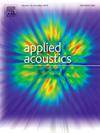基于稀疏点阵模式波包分离算法的钢轨缺陷检测
IF 3.4
2区 物理与天体物理
Q1 ACOUSTICS
引用次数: 0
摘要
在不规则和复杂的截面结构中,导波的模态数量非常丰富,在损伤检测过程中很容易无法分离出各个模态的波包并检测出反射回波。为了满足单模态分析对无损检测和结构健康监测的需求,本文创新性地提出了一种基于稀疏点阵列的波包分离算法,建立了实用的结构缺陷检测工作流程,首次实现了在少量接收点下对钢轨缺陷的准确识别与定位。本文利用波导的传播特性构造了波包的频响矩阵,并结合伪逆算法推导了基于稀疏点矩阵的模式分离公式。同时,确定了单点激励点位置的选择规则,通过二维傅里叶变换获得了波导结构的准确传播特性,并根据波形信息判别原理提出了最优接收距离计算方法。进一步形成了基于模波包分离的结构缺陷检测工作流程,实现了各模波包与反射波包的分离。最后,在所有接收点都布置在钢轨腹板内的情况下,仿真实现了钢轨头部、钢轨腹板和钢轨底座缺陷的定位,以及缺陷尺寸和纵向位置的识别,并通过实验进行了验证。本文章由计算机程序翻译,如有差异,请以英文原文为准。
Rail defect detection based on mode wave packet separation algorithm of sparse point array
The number of guided wave modes in irregular and complex cross-sectional structures is so abundant that it is easy to fail to separate the wave packets of each mode and to detect the reflected echoes during damage detection. In order to meet the needs of non-destructive testing and structural health monitoring for single mode analysis, this paper innovatively proposes a wave packet separation algorithm based on a sparse point array, establishes a practical structural defect detection workflow, and realizes for the first time the accurate identification and localization of rail defects under a few received points. In this paper, the frequency response matrix of the wave packet is constructed by the propagation characteristics of the waveguide, and the mode separation formula based on the sparse point matrix is derived by combining the pseudo-inverse algorithm. At the same time, the selection rule of the single-point excitation point position is determined, and the accurate propagation characteristics of the waveguide structure are obtained by the two-dimensional Fourier transform, and an optimal receiving distance calculation method is proposed according to the principle of waveform information discrimination. The structural defect detection workflow based on mode wave packet separation is further formed, and the separation of each mode wave packet and the reflection wave packet is realized. Finally, in the case where all the receiving points are arranged in the rail web, the simulation realizes the localization of the defects in the rail head, rail web, and rail base, as well as the identification of the defect size and longitudinal position, and is verified by experiment.
求助全文
通过发布文献求助,成功后即可免费获取论文全文。
去求助
来源期刊

Applied Acoustics
物理-声学
CiteScore
7.40
自引率
11.80%
发文量
618
审稿时长
7.5 months
期刊介绍:
Since its launch in 1968, Applied Acoustics has been publishing high quality research papers providing state-of-the-art coverage of research findings for engineers and scientists involved in applications of acoustics in the widest sense.
Applied Acoustics looks not only at recent developments in the understanding of acoustics but also at ways of exploiting that understanding. The Journal aims to encourage the exchange of practical experience through publication and in so doing creates a fund of technological information that can be used for solving related problems. The presentation of information in graphical or tabular form is especially encouraged. If a report of a mathematical development is a necessary part of a paper it is important to ensure that it is there only as an integral part of a practical solution to a problem and is supported by data. Applied Acoustics encourages the exchange of practical experience in the following ways: • Complete Papers • Short Technical Notes • Review Articles; and thereby provides a wealth of technological information that can be used to solve related problems.
Manuscripts that address all fields of applications of acoustics ranging from medicine and NDT to the environment and buildings are welcome.
 求助内容:
求助内容: 应助结果提醒方式:
应助结果提醒方式:


